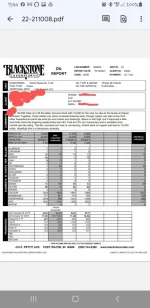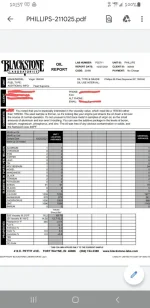So I'm running a 2004 series 60 engine, non egr, non emissions engine. Running Phillips 66 15w40 fleet supreme during the break in period.
I built it last January, got it installed and ran it 13k miles and grenaded it due to a typographical error on my part.
Anyways, rebuilt it, fixed what I screwed up and got it going. So we're 30k miles on this new engine and the oil samples are getting worse. When I blew it up I put 6 gallons of antifreeze in the oil pan, so our initial concern was residual antifreeze in the engine from the catastrophic failure, so far all the samples have showed great results with little to no antifreeze and numbers going in the right direction.
So today I get my sample back and I have high copper and high lead, silicon has also been high and I'm not sure why, I've been all over the intake system, new air filters, checked boots, clamps, everything. The thought is sealants used to build the engine, which the second time was minuscule use of sealants..
So our concerns are the current levels. So if you see in my samples. First sample was 3k, then 14k(which was a 10k oil change interval) and the latest was at 30k(a 15k interval). The engine is not stock, our rough guess is somewhere in the 6-650 HP range to the wheels, total shot from the hip based on how my original engine performed at 540 dyno rwhp. I've never had a fuel dilution or low viscosity issue when running Chevron.
So we are wondering thoughts on the oil, could the oil be causing the issues? Is it maybe the wrong oil for a high horsepower application? The fuel dilution we're checking into, the only fix for sure is to pull them and test them. A cutout test will only tell us so much. We're wondering if maybe the oil is thinning faster from the added horsepower and it's causing these issues.
Also, silicon, thoughts? Filters are brand new, I've put everything on new, I'm about out of things to change. But I'm open to suggestions. I've pressure tested the CAC and it holds 25 psi for 20-30 mins no issues. Thoughts? Questions?
I built it last January, got it installed and ran it 13k miles and grenaded it due to a typographical error on my part.
Anyways, rebuilt it, fixed what I screwed up and got it going. So we're 30k miles on this new engine and the oil samples are getting worse. When I blew it up I put 6 gallons of antifreeze in the oil pan, so our initial concern was residual antifreeze in the engine from the catastrophic failure, so far all the samples have showed great results with little to no antifreeze and numbers going in the right direction.
So today I get my sample back and I have high copper and high lead, silicon has also been high and I'm not sure why, I've been all over the intake system, new air filters, checked boots, clamps, everything. The thought is sealants used to build the engine, which the second time was minuscule use of sealants..
So our concerns are the current levels. So if you see in my samples. First sample was 3k, then 14k(which was a 10k oil change interval) and the latest was at 30k(a 15k interval). The engine is not stock, our rough guess is somewhere in the 6-650 HP range to the wheels, total shot from the hip based on how my original engine performed at 540 dyno rwhp. I've never had a fuel dilution or low viscosity issue when running Chevron.
So we are wondering thoughts on the oil, could the oil be causing the issues? Is it maybe the wrong oil for a high horsepower application? The fuel dilution we're checking into, the only fix for sure is to pull them and test them. A cutout test will only tell us so much. We're wondering if maybe the oil is thinning faster from the added horsepower and it's causing these issues.
Also, silicon, thoughts? Filters are brand new, I've put everything on new, I'm about out of things to change. But I'm open to suggestions. I've pressure tested the CAC and it holds 25 psi for 20-30 mins no issues. Thoughts? Questions?


